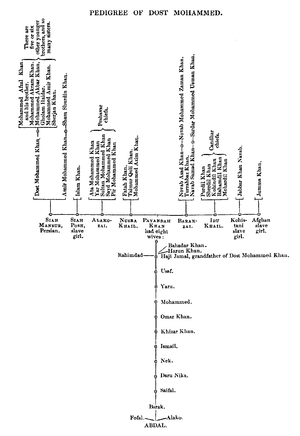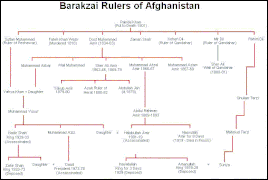Barakzai
Bārakzai (Pashto: بارکزی, bārakzay, plur. bārakzī) is the name of a Pashtun tribe from present-day, Kandahar, Afghanistan. '"Barakzai" is a common name among the Pashtuns and it means "son of Barak" in Pashto.[1] There are seven distinct Pashtun tribes named Barakzai, with the Zirak branch of the Durrani tribe being the most important and largest tribe with over 4 million people.[2]
| Total population | |
|---|---|
| several millions | |
| Regions with significant populations | |
| Afghanistan, Pakistan | |
| Languages | |
| Pashto, Dari, Balochi | |
| Religion | |
| Sunni Islam | |
| Related ethnic groups | |
| other Pashtun tribes |
History
Ludwig W. Adamec wrote that the Barakzai are "an important section of the Zirak branch of the Durrani to which the former Barakzai/Muhammadzai ruling family belongs. In numbers, economic, and political strength, the Barakzai were the paramount tribe of Afghanistan...They were soldiers in the service of Nadir Shah, founder of the short-lived Afsharid dynasty in Iran, and were settled on land seized from the Ghilzai. They continued to hold jagirs, fiefs, in exchange for their military services to Ahmad Shah Durrani. When Painda Khan, leader of the Barakzais, was assassinated, the Barakzai chiefs under Dost Muhammad ousted and replaced the Sadduzai dynasty. The Barakzai continue to possess large areas of agricultural land and extensive flocks in the area between Herat and Kandahar."[3]


Mohammadzai
Mohammadzai are the most prominent & powerful sub-tribe of Barakzai, they belong to the Zirak branch of the Durrani confederacy, and are primarily centered around Kandahar. They can also be found in other provinces throughout Afghanistan as well across the border in the Pakistan's Balochistan Province.
The Musahiban, originally the Yahya Khel clan,[4][5] are descendants of Sultan Mohammad Khan. Mohammadzai Barakzai are closely related to Amanullah Khan.
Payendah Khel are descendants of Payendah Khan, head of the Mohammadzai branch of the Barakzai tribe during the reigns of Timur and Zaman Shah, who became rulers with the decline of the Sadozai dynasty.
The Tarzi family is a branch of the Mohammadzai of Afghanistan. The founder of Tarzi family was Ghulam Muhammad Tarzi.
Politics
From 1826 to 1978, most rulers of Afghanistan belonged to the two branches of one Barakzai dynasty descending from the chiefs of the Barakzai tribe (belonging to the Mohammadzai sub-tribe).[6]
- Emir Dost Muhammad Khan Barakzai - (First Mohammadzai Ruler)
- Emir Sher Ali Khan - Emir of Afghanistan
- Emir Yaqub Khan - Emir of Afghanistan, Signed treaty of Gandamak.
- Emir Abdur Rahman Khan - Emir of Afghanistan (October 1879/July 22, 1880 – October 3, 1901)
- Emir Habibullah Khan - Emir of Afghanistan (October 3, 1901 - February 20, 1919)
- Emir Amanullah Khan - Emir of Afghanistan (February 28, 1919 – 1926)
- King Amanullah Khan - King of Afghanistan (1926 - January 14, 1929)
- Queen Soraya Tarzi (w. of King Amanullah Khan) (November 29, 1899 - April 20, 1968).
- King Inayatullah Khan (January 14, 1929 - January 17, 1929).
- Mahmud Tarzi - Poet, Author and Diplomat. Credited for the modernization of Afghanistan.
- Sardar Ghulam Muhammad Tarzi - Poet, Ruler of Kandahar & Baluchistan.
- Sardar Rahmdil Khan - Ruler of Kandahar & Baluchistan.
- Sardar Payinda Khan - Ruler of Kandahar & Baluchistan. Father of All Mohammadzai's
- King Mohammed Nadir Shah (October 17, 1929 - November 8, 1933).
- King Mohammed Zahir Shah (November 8, 1933 - July 17, 1973.
- President Mohammed Daoud Khan (First Afghan President) (July 18, 1973 - April 28, 1978)
Languages
The principal language of Barakzai is Pashto. Dari is also used as the language for records and correspondence.[7][8][9]
References
- Martin, Mike (2014). An Intimate War: An Oral History of the Helmand Conflict, 1978-2012. Oxford University Press. p. 321. ISBN 978-0199387984. Retrieved 26 July 2016.
In Pushtun folklore, Barak, Alak and Popol were brothers who went their separate ways to found tribes in their own namesake with the addition of the—zai (son of) suffix, for example, Barakzai.
- Balland, D. "BĀRAKZĪ". Encyclopædia Iranica (Online ed.). United States: Columbia University.
- Adamec, Ludwig W. (2011). Historical Dictionary of Afghanistan 4th revised edition. Scarecrow Press. p. 81. ISBN 978-0810878150. Retrieved 26 July 2016.
- "Help for Researchers". The British Library. British Library. Retrieved 3 September 2016.
- Saikal, Amin (2004). Modern Afghanistan: A History of Struggle and Survival. B. Tauris. pp. 47–49. ISBN 978-1850434375. Retrieved 31 May 2016.
- Afghanistan - Ethnic Groups
- Pakistan and the emergence of Islamic militancy in Afghanistan By Rizwan Hussain Page 16
- page 64 India and Central Asia By J. N. Roy, J.N. Roy And B.B. Kumar, Astha Bharati (Organization)
- Study of the Pathan Communities in Four States of India Archived May 14, 2008, at the Wayback Machine, Khyber.org (retrieved 30 January 2008)